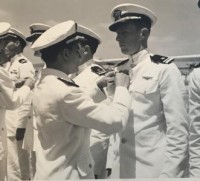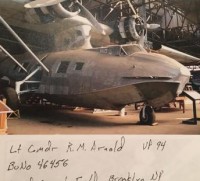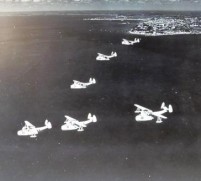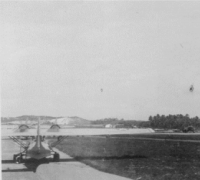U.S. NAVY VP SQUADRONS IN BRAZIL - THE TIMES OF RICHARD ARNOLD AT VP 94
1)THE NAVY AS I LIVED IT
The text below is part of the diary of Lieutenant Richard Arnold of the US Navy and his experiences lived in the South Atlantic, specifically at the VP 94 Squadron which was based on several Naval Air Stations along the extensive coast of Brazil and culminated in his brilliant participation in the training of officers of the Brazilian Air Force in PBY-5 having after the course being assigned 18 aircraft to Brazil. Lieutenant Richard Arnold returned to the U.S. in early 1945 and continued his career in the US Navy. This article is a contribution kindly sent by his son Jack Arnold.
Jack has asked that I write down some of my World War II experiences so that you will all know what a hero I was. It is embarrassing but I’ll try. While my service experiences were fairly tame and really did little to influence the outcome of the war, nobody would have known that ifI had just kept my mouth shut. Now, my cover will be blown! Everybodv knows that World War II started for the United States on December 7, 194 l. That was a Sunday and I was at home at 5555 Pershing in St. Louis. My buddy, Mike Rees who lived across the street, came running over hollering that Pearl Harbor had been bombed by the Japanese and we were at war. He wanted to go right down and enlist in the navy (which he did) and wanted me to go along.
Fortunately for me, I had taken the entrance exam for the Naval Academy and was waiting for the results. I was still nineteen and at that point was committed to the Academy, but they weren’t committed to me apparently. For some reason, it took them until May 23, 1942, to grade my paper. Somebody must have tampered with my answers because by that time many of them were wrong. Enough that I had flunked chemistry and physics. I later found out that you could be a naval officer without those two things. As a matter of fact, I believe there are some fairly basic laws of physics involved in keeping airplanes in the air which I was able to do for many years. The good news was that while the Navy was grading my paper, they found that they were desperately in need of naval aviators.
When the war started there had been a requirement to become an aviation cadet it was necessary to have two years of college. The college requirement was eliminated during that time opening the door to what I really wanted, to fly. On May 23, I received my notification from the Naval Academy, called my dad and asked him to sign my enlistment papers. He agreed and I went down to the recruiting office in the Federal Building and enlisted that day.
There had been some changes made in the Navy flight training program as a result of the heavy losses they were suffering in the Pacific. They found that many of the pilots were surviving the crashes, but couldn’t handle the rugged jungle terrain or the hours waiting to be rescued in the ocean. They determined that there should be three month pre-flight training program which was almost entirely physical training.
When I enlisted in May there were no immediate openings for pre-flight school so I was ordered to take a civilian pilot training course (CPI) which would give us 35 hours of flight training while we waited to get into pre-flight school. The course was given through Jefferson College located at the downtown YMCA in St. Louis. We lived at the Y and flew out of Private Flyers Airport, a small grass field in St. Charles.
We reported around July 7, 1942, were issued one khaki uniform and started flying on the 14th. My instructor was a big country boy named Harley Weiss. He was a great pilot and an instructor that really made his students feel at ease. He never got excited, including when we had the prop stop dead while we were upside down at the top of a loop. Diving out of the loop started the prop again. He just laughed.
CPT was just a time filler. lt did expose us to some simple maneuvers such as stalls, spins, wing-overs and got us past our first solo after eight hours of dual instruction. It also allowed some of us to change our minds about flying. Only one quit that I can recall. The airplanes were J-3 Piper Cubs which were really powered gliders. The engines were about 65 horsepower so they obviously didn’t go very fast. We managed to get in about fifteen hours of solo flight which stood us in good stead when we got into Navy primaiy flight training. We completed CPT around the end of August and ,waited for orders to Pre-flight School. I was ordered to Iowa City shortly thereafter and started my Navy career in the 20th Battalion at the University of Iowa. Pre-flight School had only been in existence about four and a half months. We reported around the first of October.
There were a number of people that had gone through CPT with me so I did know quite a few people. We left from the old Union Station on Market Street in downtown St. Louis in the afternoon on a cattle car. We arrived in Iowa city around 2:00 or 3:00 in the morning, checked in, drew our gear and finally got to bed around 4:30 A.M. Our first experience with reveille came about an hour later. We were sure that we would be able to stay in bed because we had just gotten there. Wrong! We went to calisthenics, then breakfast, then the first of many Navy physicals. We received shots against everything. Then we were given a series of tests designed to determine what kind of shape we were in. I thought I was in pretty good shape but nothing like they wanted. When we finished those tests we could barely make it to our rooms. The combinations of the shots and the tests caused a lot of people to faint and get sick.
Somebody would run for the duty cadet because we had no idea what to do. They would come down, take a look and tell us to let him lay. It didn’t take long to find out that we would be on our own the whole time we were there. The pre-flight school syllabus consisted mostly of physical training, bodily contact sports, obstacle courses and distance meaning. There were some classes, usually one in the morning and one in the afternoon. They were mostly indoctrination into Navy regulations, history, etc. We learned that a wall is a bulkhead, stairs are ladders, ahead is forward, behind is aft. Right and left were now starboard and port. We also learned how to march. We had precision drill and marched to the Navy band. We all really enjoyed that.
The instructors at all pre-flight schools were ex-professionals or world class athletes who were commissioned to do just that job. The head of the cadet regiment was Bernie Bierman, former coach at Minnesota. Our platoon officer was Jim Langhurst, All-American running back from Ohio State. The wrestling and boxing instructors were ex-professionals. The soccer coach, a former Olympic distance runner. Our days started around 05:30 with calisthenics and then breakfast. After that we had boxing, a class, football, lunch followed by the same routine in the afternoon. The last hours in the afternoon was our varsity sport. Each of us had a variety sport which we had everyday for the entire time we were there. The other hours were rotated with football, boxing, wrestling, Judo, soccer, obstacle course, rope climbing, swimming and miscellaneous other tortures. There were a number of long marches thrown in to round out our education.
My varsity sport was wrestling. The coach, was a former professional wrestler. We wrestled almost everybody that had wrestling as their varsity sport. Weight was not a major problem as far as they were concerned, you just fought everybody. Same thing was true with boxing. I weighed about 135 pounds at the time, but I only lost one match to a college wrestler named Joe Clark. Unfortunately, Joe was the first one of our group to be killed in flight training. My only claim to fame was to win a twenty-six man free-for-all. We had thirteen on a team, all met in the middle of the ring and the last one standing was the winner. We eliminated the other team first, then each other.
Our twelve weeks were cut to ten due again to heavy losses in the Pacific. As a result we got our orders to primary flight training two weeks early. I was ordered to Glenview Naval Air Station near Chicago around the middle of December 1942.
Cont.



